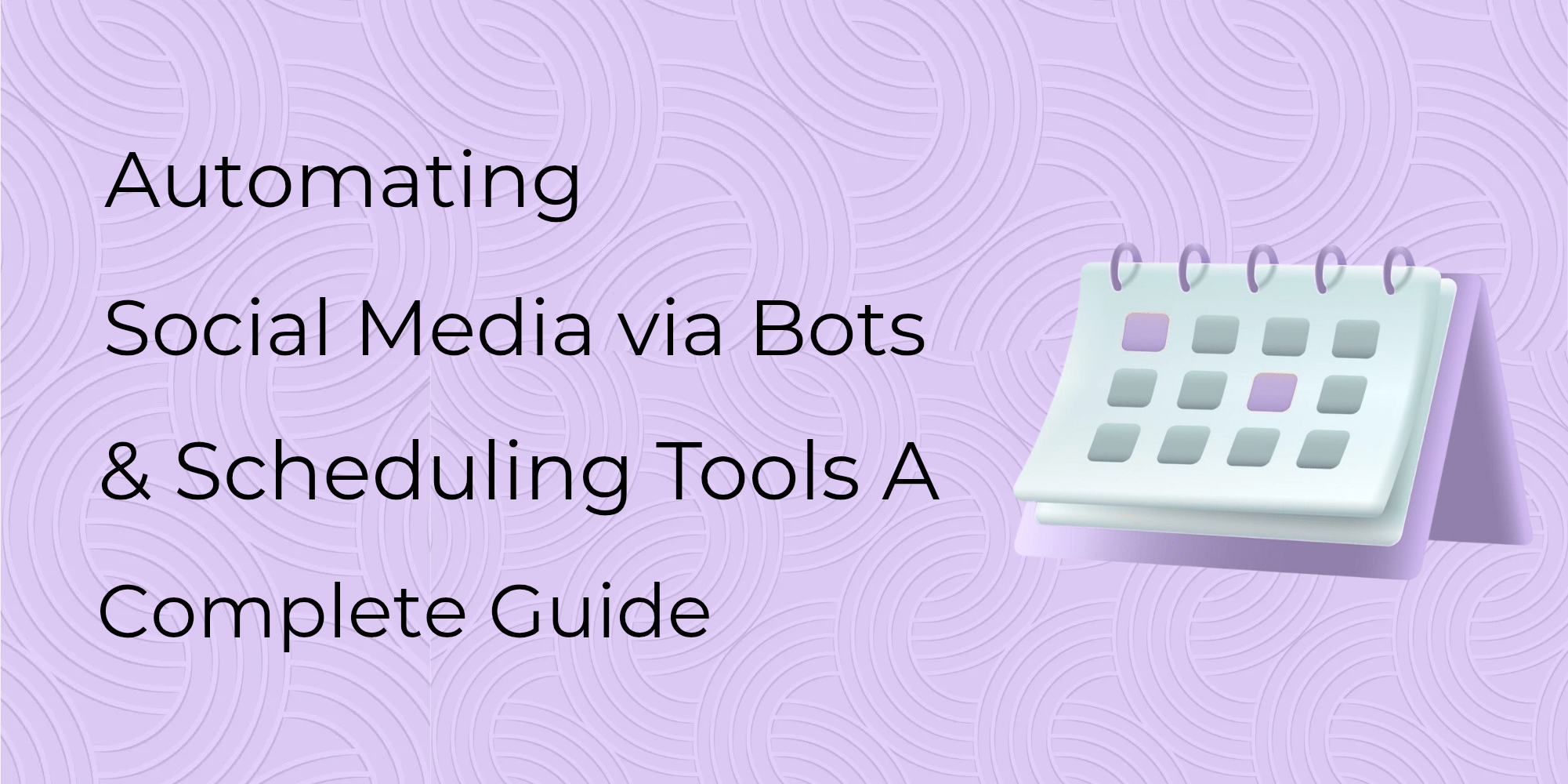Social media is no longer merely a space to post personal updates in today’s quick-paced digital age. It’s a vital tool for companies, influencers, and organisations to reach their audience, create brand awareness, and generate engagement. However, it’s time-consuming, tedious, and inconsistent to manually manage multiple social media sites.
That’s where automation fits in. With the use of bots and scheduling tools, companies and individuals can automate social media tactics, maintain consistency, and achieve maximum efficiency.
● The Role of Bots in Social Media Automation
Bots are software applications that perform a certain action automatically. On social media, they can be employed for:
- Chatbots: They are AI-driven bots that interact with users through direct messages, popularly used in channels such as Facebook Messenger or Instagram DMs.
- Follow/Unfollow Bots: They are bots that follow or unfollow users automatically to gain exposure. They are problematic and go against platform terms.
- Engagement Bots: They like, comment, or share on posts based on predefined criteria or hashtags.
- Monitoring Bots: They monitor brand mentions, hashtags, or competitors.
But whereas bots do enhance efficiency, overuse or abuse can hurt credibility, frustrate users, and even result in accounts being banned.
● Benefits of Social Media Automation
- Saves Time
Rather than having to log in to all platforms every day to make posts, automation software enables scheduling weeks or months beforehand. It saves time on daily posting and allows marketers to concentrate on broader strategy. - Consistency
Consistency is essential in social media marketing. Scheduled posts keep your audience listening to you on a regular basis, even when you are not available online or on leave. - Best Timing
Most automation tools track your audience’s behaviour and provide the optimal posting times to maximise engagement. - Enhanced Engagement
Some automation tools have auto-reply, instant response, and chatbot integration features that keep engagement going 24/7, which is particularly essential for international audiences. - Performance Monitoring
Automation tools tend to feature analytics dashboards that assist in monitoring reach, clicks, conversions, and engagement metrics, making it simpler to determine ROI.
● Top Social Media Automation Tools
These are some of the most common tools used to automate social media:
- Buffer
Buffer enables you to schedule posts, review performance, and manage several accounts on one dashboard. Its simple interface and team collaboration capabilities make it a business-friendly tool. - Hootsuite
One of the most ancient tools available, Hootsuite has support for more than 35 social networks. It has post scheduling, content curation, social listening, and analytics. - Later With a major focus on visual sites such as Instagram and Pinterest, Later has a visual content calendar, hashtag suggestions, and link-in-bio capabilities.
- Sprout Social
Sprout Social is a robust all-in-one platform that integrates scheduling, monitoring, reporting, and CRM features and thus is ideal for enterprise users. - Chatfuel / ManyChat
These are Facebook and Instagram chatbot platforms that help automate customer support, lead capture, and FAQs. - SocialBee
Targeting small businesses, SocialBee provides category scheduling, content recycling, and concierge content creation services. - Zapier + Social Media
With automation tools such as Zapier, you can link apps (e.g., RSS feeds, Google Sheets, CRMs) to social media for advanced, trigger-based automation.
● Best Practices for Social Media Automation
While automation is incredibly powerful, it must be done strategically. Some best practices are:
- Automate with a Human Touch
Don’t sound like a machine. Even automated messages should sound like your brand voice and feel personal. Use emojis, natural language, and content specific to the context. - Don’t Automate Engagement
Liking miscellaneous posts or commenting generic messages with robots makes it sound like spam. Use automation for posting, not engagement. - Monitor Scheduled Content
Things happen fast online. A timed post could be out of place following surprise events. Check your content calendar frequently. - Leverage Analytics to Optimize
Don’t automate and forget. Analyse engagement habits, post performance, and responses. Adjust strategy based on insights. - Adhere to Platform Rules
Every social network has automation policies. Instagram and Twitter, for instance, dislike intensive bot-based engagement. Terms of service violations may result in shadowbanning or lifetime bans.
● Ethical Considerations of Using Bots
Social media users value authenticity. When automation crosses the line into deception or manipulation, it creates ethical problems. Here are a few considerations:
- Transparency
If using bots or chatbots, let users know they’re not speaking to a human. Transparency builds trust. - Privacy
Automation tools often collect user data. Always comply with GDPR, CCPA, or local data protection laws when handling personal information. - Avoid Spammy Behavior
Automated DMs, spammy comments, and pushy follows can kill your brand image. Prioritise quality over quantity. - Real Engagement Matters
Automation should support, not substitute, true conversations. Particularly in crisis management, human monitoring is essential.
● Social Media Automation Risks and Challenges
Although automation is great, it has a few risks and pitfalls.
⚠️ Over-Automation
Depending too much on automation can make your brand come across as robotic or impersonal. Audiences appreciate authenticity.
⚠️ Spammy Behavior
Bot DMs or aggressive follow/unfollow strategies can break platform guidelines and annoy users.
⚠️ Algorithm Penalties
Social networks such as Instagram and X (Twitter) enforce drastic measures against bot behaviour. Abuse can result in shadowbans or account suspension.
⚠️ Missed Real-Time Moments
Automation can’t keep up with breaking news or cultural changes. A timed post might sound insensitive in response to recent events.
⚠️ Technical Glitches
Posts might not go live because of API problems or tool malfunctions — always keep an eye on your automated tools.
● Best Social Media Automation Tools 2025
Chatbots & Interaction Bots
- ManyChat
Excellent for Messenger, Instagram, and WhatsApp bot lead capture flows. - Chatfuel
No-code bot creator perfect for e-commerce and service firms. - MobileMonkey
Integrated chatbot platform for live chat, bots, and SMS. - Tidio
Integrates live chat and AI bots suitable for small enterprises.
● Future of Social Media Automation
As AI becomes more sophisticated, we’re moving toward hyper-personalised automation. Expect to see:
- AI-generated content customized per follower
- Deep sentiment analysis in bots
- Predictive analytics suggesting post topics or times
- Automated video and reel generation
- Smart scheduling that adapts to audience mood or behavior in real-time
But as automation becomes smarter, authenticity will continue to be paramount. Brands that meld intelligent automation with real human touch will be the leaders.
Final Thoughts
Social media automation isn’t about replacing humans—it’s about enabling humans to do what they do best: be creative, develop strategy, and have genuine human connections.
Whether you’re a freelancer looking to grow your presence or a global brand juggling dozens of campaigns, bots and scheduling tools offer a scalable, efficient path to success. But use them wisely—plan thoughtfully, monitor performance, and never lose sight of your audience’s need for real engagement.


